Physical Address
304 North Cardinal St.
Dorchester Center, MA 02124
The placenta is a fetally derived organ present in the maternal uterus; it has many different functions, including serving as a barrier to infection. Maternal infectious diseases and vaginal colonization can lead to congenital infections if the placental barrier is breached. The fetus develops in a fluid-filled space surrounded by membranes composed of two epithelial-mesodermal layers, the amnion and chorion ( Fig. 18.1 ). These membranes generally cover the endocervical os. The fetus and its fluid environment are thus isolated from the microorganisms in the cervicovaginal vault by only four layers of tissue and the cervical mucus. The human placental disk adheres to the maternal uterus via direct colonization of the uterine vascular bed beneath and is directly exposed to maternal blood. Organisms can gain entry into the placenta by direct hematogenous spread or by breaching the membranes over the endocervix, resulting in ascending infection. Fetal infection can follow, but this depends on many factors, including the type and number of microorganisms and the maturity of the fetal immunologic response.
The histologic hallmark of ascending infections is acute chorioamnionitis (ACA). Organisms reach the amniotic fluid, where they multiply and stimulate an inflammatory response from the mother and fetus. Histologically, presence of inflammatory cells within the fetal membranes ( Fig. 18.2 ) represents the maternal inflammatory response to microorganisms in the amniotic fluid. The fetal response is diagnosed by the presence of inflammatory cells derived from the fetus in the umbilical cord or chorionic plate vessels, or both ( Fig. 18.3 ). The diagnosis of histologic ACA should be made if there is sufficient inflammation to warrant it and should be staged as to the anatomic location and source of the inflammation. Redline et al. have provided a grading and staging system that is summarized in Table 18.1 .
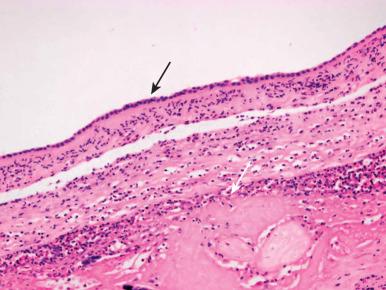
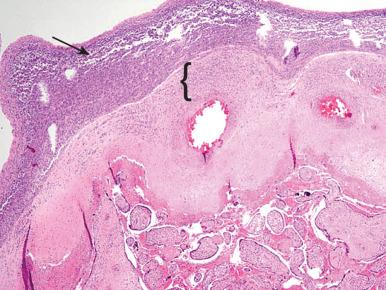
| Diagnostic Category | Definition |
|---|---|
| Maternal Inflammatory Response | |
| Stage (Location) | |
| 1 (Early) | Neutrophils in subchorionic fibrin, in chorionic plate, or in chorionic epithelial layer of membranes |
| 2 (Intermediate) | Neutrophils within chorionic or amnionic mesoderm |
| 3 (Advanced) | Stage 2 plus necrosis of amnionic epithelium and/or neutrophils |
| Grade (Severity) | |
| 1 (Mild to moderate) | Anything less than severe (grade 2) |
| 2 (Severe) | Confluent or more than three foci ≥200 cells |
| Fetal Inflammatory Response | |
| Stage | |
| 1 (Early) | Fetal inflammatory cells within chorionic plate vessel walls or umbilical vein vessel wall or both |
| 2 (Intermediate) | Fetal inflammatory cells within umbilical arteries ± vein |
| 3 (Advanced) | Necrotizing funisitis |
| Grade | |
| 1 (Mild to moderate) | Not severe (grade 2) |
| 2 (Severe) | Confluent fetal inflammatory cells with attenuation/degeneration of smooth muscle |
The diagnosis of ACA is established clinically when one or more of the following features are present: maternal fever, fetal tachycardia, uterine tenderness, and pus per cervical os. The most common use of the diagnosis is with maternal fever in labor. The histologic confirmation of this clinical diagnosis is poor, with less than a 25% concordance rate.
The clinical significance of ACA is, first, that it is one of the most common causes of preterm labor. In addition, the presence of ACA stimulates the common practice of culturing a tissue sample from the neonate and treating for a presumption of infection pending results of the culture. Newer literature suggests that the presence of a fetal response to the chorioamnionitis is associated with neurocompromise in the neonate.
Although it is largely believed that ACA is diagnostic of amniotic fluid infection, this is still not proven. In preterm chorioamnionitis the association with infection is well substantiated. Organisms responsible can be single species, such as a group G streptococcus, but most cases of ACA are polymicrobial. In third-trimester cases of ACA, and especially at term, the incidence of chorioamnionitis falls, as does the association with documented infection.
Maternal infection can spread directly to the placenta. The hallmark of this type of placental infection is villitis, an inflammatory infiltrate of the placental villi ( Fig. 18.4 ). The dominant cell type depends on the type of organism. The most common infections that occur during pregnancy and lead to sepsis are bacterial infections of the urinary tract, although these rarely cause placental infections via sepsis. The two bacterial groups that most commonly infect the placenta and result in villitis are group B streptococci (GBS) and Listeria monocytogenes . The villitis associated with these infections is termed acute villitis because the infiltrate shows a predominance of neutrophils. The classic infections that are hematogenously spread to the placenta are not bacterial but viral or parasitic and lead to chronic villitis , with a predominance of lymphocytes and plasma cells in the villous infiltrate.
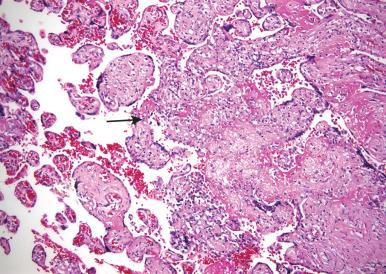
Although chronic villitis is the most common pathologic manifestation of hematogenously spread infections to the placenta, it is not specific. Chronic villitis at term is common but is thought to be very rarely caused by infection. Most cases have an unknown etiology and are thought to represent a manifestation of an immunologically based host-versus-graft reaction; therefore a recurrence risk is present, and the infection can potentially result in placental rejection with fetal sequelae. In noninfectious chronic villitis, maternal lymphocytes invade the villi. If infection is the cause of chronic villitis, it usually has distinctive features that help to distinguish it from the noninfectious type ( Box 18.1 ). The source of the inflammatory cells in infectious chronic villitis has not been studied. The pathologic workup of chronic villitis should be based on the clinical history and the presence of any of the features listed in Box 18.1 .
Prematurity
Stillbirth
NICU admission
Hydrops fetalis or placentalis
Trimmed placental weight <5th percentile
Positive HIV status in mother
Suspected or confirmed maternal illness or exposure
Marked and diffuse stromal expansion of villi
Diffuse chronic villitis with any of the following:
Plasma cells
Giant cells
Hemosiderin
Fetal normoblastemia (if >20 weeks gestational age)
Chorionic plate vascular thrombi
HIV , Human immunodeficiency virus; NICU , neonatal intensive care unit.
GBS infection is typically due to colonization, usually asymptomatic, of the genital and/or gastrointestinal tract. These bacteria infect the placenta either by ascending through the cervix into the amniotic cavity or via the urinary tract resulting in urinary tract infection and bacteremia. GBS infection is particularly lethal to the fetus because it can cause pneumonia and sepsis. For this reason, it was the focus of a recent late pregnancy screening (35 to 37 weeks) and treatment protocol in the United States. Infection during pregnancy can occur in the absence of ruptured membranes. Classically, GBS causes a necrotizing chorioamnionitis of high maternal and fetal stage ( Fig. 18.5A ). Rapid bacterial growth often allows the organisms to be readily visualized on the placental membranes (see Fig. 18.5B ). In cases of retained stillbirth, especially in the second trimester, one can occasionally see organisms filling the villous vascular spaces (see Fig. 18.5C ). The usual histology of ACA due to GBS amnionic fluid infection is nonspecific, but if necrotizing ACA is present, GBS should be strongly suspected, especially if there is high fetal and maternal stage. Umbilical cord involvement is usually limited to the vessels, but, in some cases, small surface abscesses may be present (see Fig. 18.5D ), different from the larger abscesses seen with candidal omphalitis (discussed later).
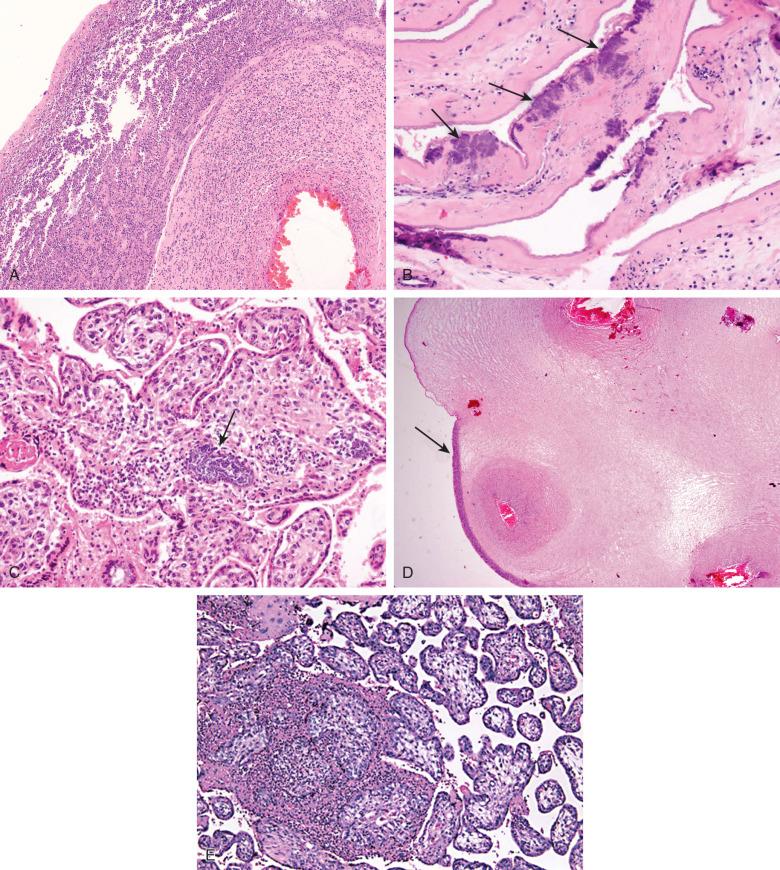
Hematogenously spread GBS can also result in acute villitis. The histology is usually an isolated villitis without necrosis or abscess formation (see Fig. 18.5E ), which helps in differentiating it from listerial placentitis (discussed later).
Fusobacterium spp. of filamentous gram-negative, anaerobic bacilli are the cause of ACA in approximately 10% of all cultured cases but in a much higher percentage of preterm ACA. They cause necrotizing ACA ( Fig. 18.6 ) comparable with that associated with GBS. The overgrowth of organisms makes them easy to identify on routine hematoxylin and eosin (H&E) staining (see Fig. 18.6 ). Silver stains or immunohistochemical studies can be used to confirm the diagnosis. The organism does not cause infection in the neonate or fetus but is associated with premature delivery due to preterm ACA.
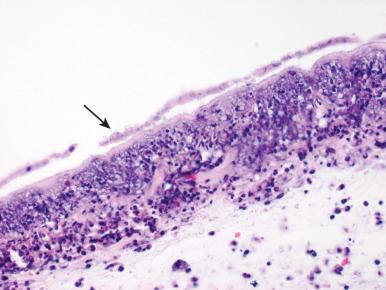
L. monocytogenes , a gram-positive motile bacterium, is a well-known perinatal pathogen. It is a common cause of septic abortion in cattle and sheep, and infection occurs in a wide variety of mammals, including humans. The organism is ubiquitous and is present in soil, water, and animal feces. Human infections result from consumption of contaminated foods, most commonly processed meats. Miniepidemics of infections have been reported as a result of the consumption of coleslaw and dairy products that were improperly pasteurized or unpasteurized.
Listeria typically produces gastrointestinal illnesses or an influenza-type disease that is self-limited. In immunocompromised hosts, older adults, and pregnant women, the infection can be serious and life-threatening. In pregnancy, a mild maternal gastrointestinal syndrome or flulike symptoms may be all that is observed, yet a marked placentitis with congenital infection can occur. Congenital listeriosis is fatal in 40% to 50% of cases. Other known complications include abortion, prematurity, and stillbirth.
The placental findings are striking and the diagnosis can be strongly suspected based on gross findings. The placenta often grossly shows infected yellow membranes (ACA) that emanate a characteristic fruity odor. Parenchymal abscesses may be large enough to be grossly diagnosed ( Fig. 18.7A ). The presence of placental abscesses should be considered evidence for the diagnosis of listerial placentitis until proven otherwise. The clinicians for the mother and infant should be immediately notified, and the microbiology laboratory should be alerted because specific culture methods may be needed to identify the organism, which grows best at slightly cooler temperatures.
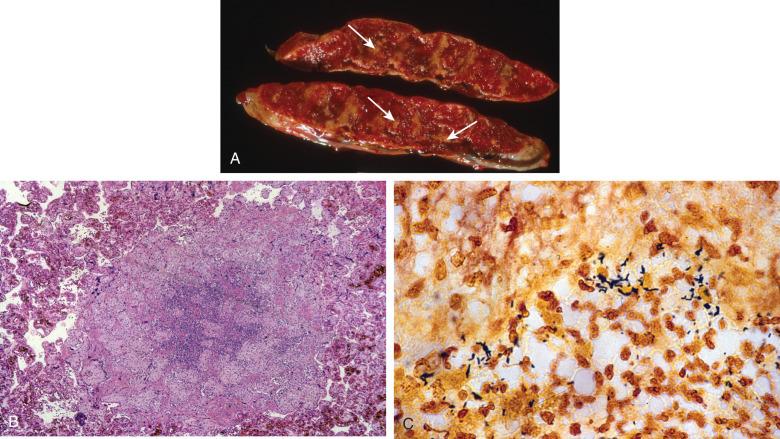
Histologically, both microabscesses and macroabscesses are present, with acute suppurative villitis (see Fig. 18.7B ) and necrotizing ACA. The organisms can be identified by silver staining or by immunohistochemistry, and they are located in the center of the abscess or in the amniotic epithelium (see Fig. 18.7C ).
M. tuberculosis is currently causing a worldwide epidemic of tuberculosis, facilitated by human immunodeficiency virus (HIV) infection, resistant strains, and poverty. Women, whether pregnant or not, are at risk for common pulmonary tuberculosis but can also be infected genitally. Congenital infections result from direct extension from an infected endomyometrium or from hematogenous spread that seeds the placenta. The fetus becomes infected by hematogenous infection in the fetal blood or by rupture of a caseous lesion into the amniotic fluid and aspiration of the fluid in utero.
The placental pathology in congenital tuberculosis is the same as for infection elsewhere, with caseating granulomas and miliary tubercles involving the villi, intervillous space, or basal plate ( Fig. 18.8 ). Also reported is granulomatous deciduitis and ACA.

Become a Clinical Tree membership for Full access and enjoy Unlimited articles
If you are a member. Log in here